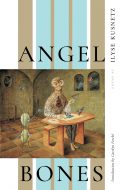 Ilyse Kusnetz
Ilyse Kusnetz
Angel Bones
Alice James Books
Reviewer: Vivian Wagner
Ilyse Kusnetz’s Angel Bones is a posthumous collection about mortality, and about finding life and connection even in the midst of – and beyond – death. Kusnetz, who died from cancer in 2016, writes about love and loss in a way that’s both lovely and bewildering. Drawing on metaphors from physics and other sciences, she explores the territory between life and death and reports back to us in poems that speak with the haunting authority of one who’s explored that liminal space in heartbreaking depth.
The collection is divided into three sections, roughly corresponding, perhaps, to the stages one goes through when dying of an extended illness: from diagnosis to recognition, and finally to transformation.
The opening poem, “Blessing for Beauty,” addresses the reader at the start of this journey, delving into the abstract concept of “beauty” by trying to find its specific meanings and expressions:
Oh, trees, flowers, small animals at the bird feeder—
cardinal, blue jay, tree mouse, mourning dove,
woodpecker, grackle, squirrel—
you have all given me such pleasure,
a lift of the heart, a sudden intake of breath . . .
These small moments and expressions, the poet tells us, cannot last, but she ends, nonetheless, with a blessing that tries to give us what we must, ultimately, lose:
May this beauty fill the unexpected vistas
of your life.
May you be opened by it—to the world,
may you open, rare flowers, to each other.
The poem’s a call, too, for connection, one of the consistent themes of this collection. We might lose the ones we love, but they’ll always be present in some mysterious and enduring plane of interconnectedness.
Another of the collection’s primary themes is entanglement. In quantum physics, entanglement refers to the way that particles, once they’ve shared space and time with each other, are forever linked, no matter where in the universe they might end up. The entanglement described by physics becomes a metaphor for the poet and her beloved; even after she dies, these poems suggest, she and her beloved will be forever entangled, perhaps in both imaginative and physical ways.
“Message to a Quantum Entangled String,” for instance, speaks of a “sweet entangling,” with the poet promising her beloved that “I’ll do / whatever it takes to find my way back” after death. In another poem, “Why I Will Never Take My Eyes off You,” the poet speaks again of entanglement:
… I’ll find you again.
We’ll be entangled then, whether this universe
is the Matrix, or a hologram, our patterns
depending on one another to exist.
Entanglement, these poems suggest, starts in life and continues past death, and while on one level Kusnetz is referring specifically to herself and her beloved, in another way she uses the term to suggest that we’re all entangled, one to another, human to human, dragonfly to bird. There’s no escaping such interrelation. Because entanglement deals in matter itself rather than in particular expressions of matter, it offers a way of thinking about a kind of afterlife, both poetic and scientific.
The speaker in these poems is aware that the poems transcend the poet’s own physical existence, and so these pieces exist in a nebulous space between then and now, past and future, writing and reading. In “The Mellified Man,” the speaker describes a “chosen one” who eats so much honey that his body, blood, and bones are “given to sweetness,” and priests would “break off small pieces of him / to feed the sick, / who’d miraculously // recover.” Like the poet, whose poems become bits of honey that we break off to eat, the mellified man’s body provides physical and spiritual sustenance to those who come after. Art is sustenance, the poem suggests, serving as spiritual and emotional food for those who consume it. Art is the preserved body that keeps us going.
In the middle of the collection, there are several prose poems, linked under the main title “The Explosion Museum.” These poems further capture the spirit of interconnectedness, in this instance through an examination of various kinds of apocalypses and rebirths. The first, “The Big Bang,” describes a beginning that forms around “an atom that will later become part of you, then me, handed down through generations, through millennia, to those we love, to those who carry on after us.” In this beginning, everything that’s to come is born: “Here is where our heart fires start, the moment everything is entangled in everything else.”
The last poem in the collection is the eponymous “Angel Bones,” and it echoes and ties together the themes and images that underlie all the other poems, giving a final direction to the collection as a whole. The poem begins “Even angels in cages are magnificent. / Even angels in cages are powerful,” suggesting that infinity, when limited, is still infinity. Like those angels, the poet is “bound now,” by her body and physical existence, but, she tells us, “my wings still work.” There’s a kind of immortality the poet claims for herself in this poem, not as a single being who will live forever, but as the matter of the universe, which will remain even after she dies:
Someday when I wriggle out of prison,
when I higgledy-piggledy, smuggle myself
past nebulae and galaxy, past black hole
and even horizon, you’ll witness my glory
again—infinite pieces of myself like a shining trail,
snail sparkle, diamond dust, coronas
and fireworks, sheer will urging me on to you,
always to you. The only home these angel bones know.
When she escapes from the prison of her body, she’ll be free-floating sparkle and dust, and she’ll always be returning “to you.” This “you” is, as it is throughout this collection, her beloved, but also the many readers of these poems, all the other possible beings connected to the poet and to each other. “Angel Bones” is a poem that is, like the collection itself, about merging, oneness, and the pulsing life to be found in and after death.

